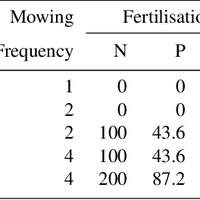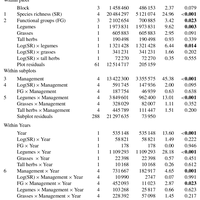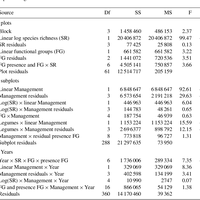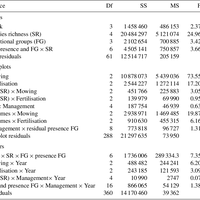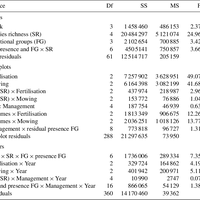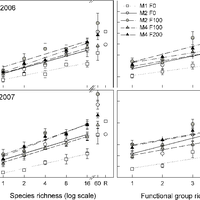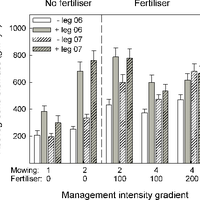Abstract
Modern grassland management seeks to provide many ecosystem services and experimental studies in resource-poor grasslands have shown a positive relationship between plant species richness and a variety of ecosystem functions. Thus, increasing species richness might help to enhance multifunctionality in managed grasslands if the relationship between species richness and ecosystem functioning is equally valid in high-input grassland systems. We tested the relative effects of low-input to high-input management intensities and low to high plant species richness. Using a combination of mowing frequencies (1, 2 or 4 cuts per season) and fertilisation levels (0, 100 and 200 kgNha-1 a-1), we studied the productivity of 78 exper imental grassland communities of increasing plant species richness (1, 2, 4, 8 or 16 species with 1 to 4 functional groups) in two successive years. Our results showed that in both years higher diversity was more effective in increasing productivity than higher management intensity: the 16-species mixtures had a surplus of 449 gm-2 y-1 in 2006 and 492 gm-2 y-1 in 2007 over the monoculture yields whereas the high-input management resulted in only 315 gm-2 y-1 higher productivity in 2006 and 440 gm-2 y-1 in 2007 than the low-input management. In addition, high-diversity low-input grassland communities had similar productivity as low-diversity high-input commu nities. The slopes of the biodiversity - productivity relationships signi?cantly increased with increasing levels of management intensity in both years. We conclude that the biological mechanisms leading to enhanced biomass production in diverse grassland communities are as effective for productivity as a combination of several agricultural measures. Our results demonstrate that high-diversity low-input grassland communities provide not only a high diversity of plants and other organisms, but also ensure high forage yields, thus granting the basis for multifunctional managed grasslands. © Author(s) 2009.
Figures
Register to see more suggestions
Mendeley helps you to discover research relevant for your work.
Cite
CITATION STYLE
Weigelt, A., Weisser, W. W., Buchmann, N., & Scherer-Lorenzen, M. (2009). Biodiversity for multifunctional grasslands: Equal productivity in high-diversity low-input and low-diversity high-input systems. Biogeosciences, 6(8), 1695–1706. https://doi.org/10.5194/bg-6-1695-2009

